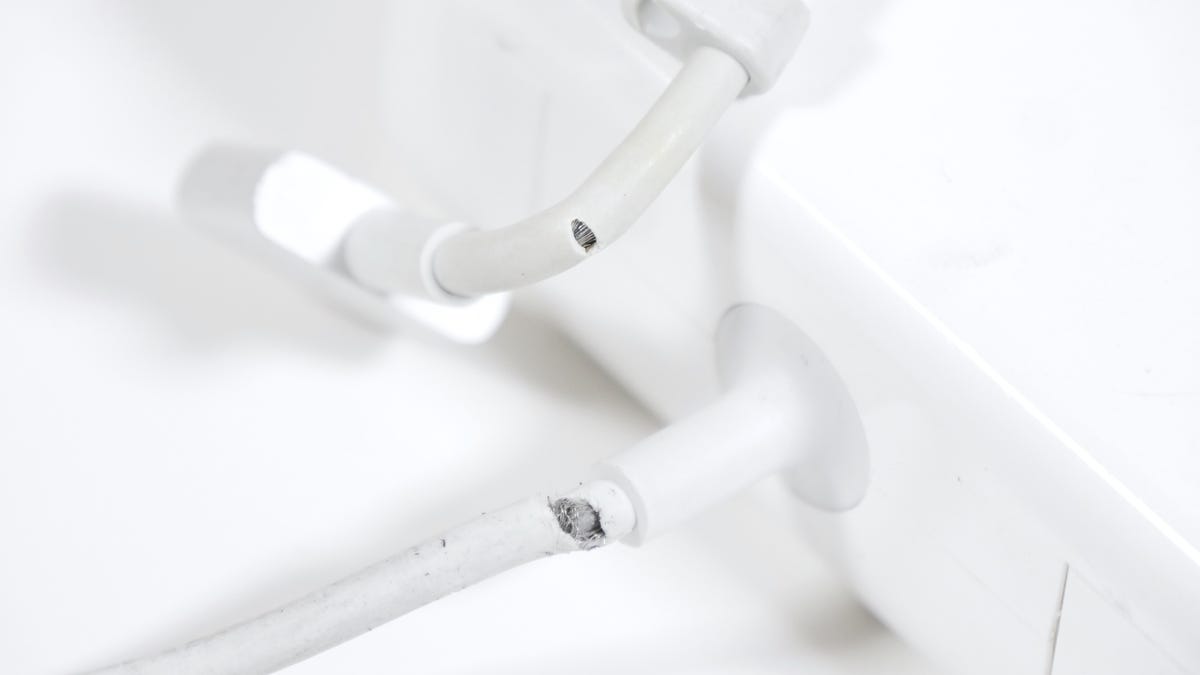 Why You Can Trust CNET
Why You Can Trust CNET 5 easy ways to fix fraying cables
It's a fact of life. Cables break, usually at the worst times possible. However, these easy steps can breathe some extra life into your most commonly used cables.

Cables often fray, but there are easy ways to keep them together a bit longer.
Most cables get plugged in and left alone for years at a time. All those power and HDMI cables connecting your home entertainment system together rarely get touched. The cables meticulously organized at your work desk may as well be cemented in place.
But the cables we use everyday -- the computer and smartphone chargers -- go through hell. They get twisted, yanked and bent on a daily basis, and they're bound to fail at some point.
If one of your cables is beginning to fray, you can counteract the damage with one of these quick fixes.
Electrical tape
One of the most cost-effective fixes for a cable that's about to meet its end is a bit of electrical tape. It's not going to be pretty and it won't be the most secure method. But electrical tape can be found for between $1 (about £0.69 in the UK or AU$1.39 in Australia) and $5 (£3.46 or AU$6.93) per roll.
Electrical tape isn't pretty, but it's generally cheap.
You can take your time neatly wrapping the cable to reinforce it, but the best way to prevent any more damage is to wrap the split or fraying part of the cable several times with electrical tape, then work your way out from that spot. This immobilizes any breaks in the cable and helps prevent further damage. Just don't expect it to last forever.
Heat shrink
A more long-term solution is heat shrink. It's also more costly and may not work if both ends of the cable are significantly larger than the diameter of the cable itself.
Heat shrink tubing comes in an array of sizes and can range from just a few bucks to upwards of $20 (£13.81 or AU$27.73) or $30 (£20.71 or AU$41.59) for an assortment pack.
When you find a size that will fit your fraying cable, slip it over one of the ends, position the heat shrink over the affected area and use a heat gun or hair dryer on high heat to activate it. The heat will cause the tubing to shrink and cling to the cable, immobilizing and reinforcing the damaged area.
Sugru
Sugru is simply great to have on hand for a number of reasons -- one of those being old and worn out cables. It's a putty-like substance that you can mold into virtually any shape, and once you let it sit and cure for approximately 24 hours, it becomes a very strong, rubber-like material.
Molding Sugru can help fix your wires.
If you mold the Sugru over the broken part of a cable, it can help prevent any more damage to that area. However, Sugru doesn't come cheap. A 3-pack of single use packets of Sugru costs between $9 (£6.21 or AU$12.48) and $12 (£8.29 or AU$16.64). But it's very reliable.
A repurposed spring
A DIY solution that might work for a short while is removing the spring from a retractable pen, stretching it out and wrapping it around the cable to reinforce it towards one of its ends.
The problem is, these springs, especially when stretched out, aren't very rigid and they won't protect the cable from being damaged further. An alternative, though, would be to install a spring over the damaged area, followed by some heat shrink tubing. The combination of the two materials will provide extra rigid reinforcement for little to no extra cost.
Cable savers
Broken cables are a nuisance so, to no surprise at all, a number of products exist to help counteract the daily wear and tear. Also not very surprising is how pricy those products are. The TUDIA Klips are about $7 (£4.83 or AU$9.70) for a pair, which is meant to protect a single Lightning cable. That's almost one-third the price of an official Lighting cable from Apple.
Technically, they're designed to help prevent damage, but they'll also work if the ends of your cable -- no doubt the most fragile part -- have started to break. Slip one of the Klips over the cable and slide it up to the plastic connecter, then slide the lock over the Klip to secure it in place.
Searching Amazon for "cable protector" will return thousands of results for similar products.
It may be time for a replacement
If your MacBook or computer charger is beginning to give out, the cost of one of these fixes is usually a small fraction of the price of replacing the charger, which can often cost upwards of $80 (£55.24 or AU$110.90). If that's the case, it's probably best to explore your options before buying an entirely new charger.
That said, if you're dealing with a broken micro USB, Lightning or even USB-C cable, in most cases, the best option is to just replace the cable altogether. These types of cables can often be replaced with reputable third-party options for between $5 (£3.45 or AU$6.93) and $10 (£6.90 or AU$13.85).

